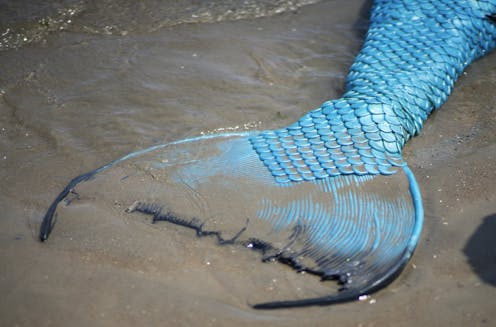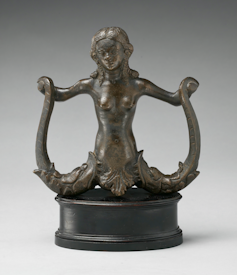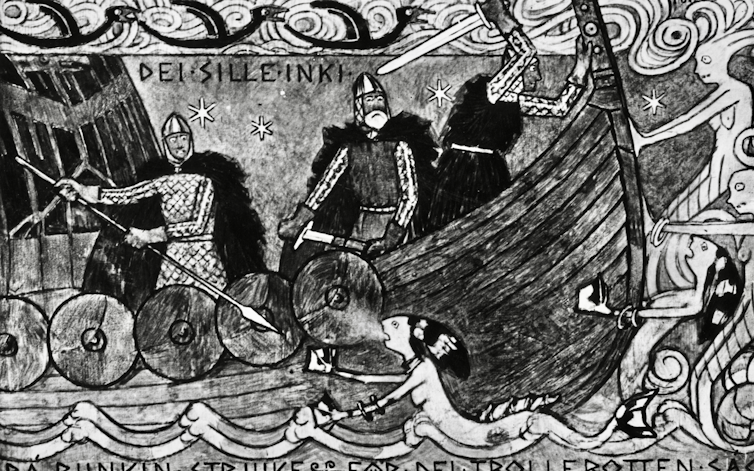Mermaids aren't real – but they've fascinated people around the world for ages
Mermaids are not real, but are meaningful to people around the world.


Curious Kids is a series for children of all ages. If you have a question you’d like an expert to answer, send it to curiouskidsus@theconversation.com.
Are mermaids real? – Verona, age 9, Owensboro, Kentucky
Mermaids – underwater creatures that are half fish and half human – do not exist except in people’s imaginations. Scientists who study the ocean for the United States have investigated their possible existence and say no evidence of mermaids has ever been found.
You might wonder why government scientists looked into this question. There are many stories about mermaids on TV, the internet and in magazines that pretend to be real science news. They try to fool people into believing mermaids are real, without any true evidence. This is called “cryptoscience” or “cryptozoology,” but it’s not real science. Don’t let intriguing stories deceive you about mermaids and other fun but made-up creatures, like Bigfoot or the Loch Ness Monster.
But just because mermaids are not real does not mean they are not meaningful. Mermaids, or merfolk as they are sometimes called because not all of them are female, have a long history and are known all over the world – the same way dragons, fairies and unicorns are.
More than one kind of mermaid
Some of the earliest mermaid stories are part of ancient Greek mythology from over 3,000 years ago. The Greeks imagined lots of creatures that were part human and part animal, like harpies (bird and human) and centaurs (horse and human).
Sometimes their mermaids were good, like the Greek goddess Atargatis, who protected humans, but others were dangerous, like the Sirens, who sang beautiful songs that made sailors crash their ships into rocks and sink. Irish mermaids, called “merrows,” which date back 1,000 years, were also considered a sign of bad luck.

Mermaid bodies have been imagined differently in different places. There’s a legendary Japanese mermaid called a “ningyo,” which is mostly a fish, but has a human face. Maybe you’ve seen the animated film “Ponyo,” about a goldfish with a little girl’s face? In Europe, there were mermaids called “melusines” who had two fish tails.
Stories about mermaids also varied depending on where and when they were told. Only some are about mermaids falling in love and wanting to be human, like Ariel and Ponyo. In the storybook “Mermaids From Mars,” for instance, mermaids have used up all the water on Mars and come to Earth to help people learn the lesson of water conservation.
In a lot of places, mermaids were used as symbols of power and wealth. For example, the city of Warsaw in Poland has a legend of a mermaid who is considered to be the protector of the city. There’s a huge statue of her there, and she is even featured on the city’s coat of arms. Many castles in Europe also have mermaid symbols to demonstrate royal power and wealth – even in countries with no oceans, like Austria.
Why mermaids?
You may wonder how mermaids came to be. Why did so many people around the world imagine them throughout history? It’s an interesting question that probably has more than one answer.

Superstitious sailors, including Christopher Columbus and others, reported seeing mermaids on their travels, but scientists and historians think they probably saw real animals, like manatees or seals.
Throughout time, people have often created stories to help explain all kinds of things they couldn’t understand at the time. Stories also help people understand their own dreams, desires and fears.
Whatever the reasons, people still clearly love mermaids. You can buy mermaid dolls, coloring books and costumes. You can find them on flags, coins and Starbucks coffee. At some aquariums and water parks, real people perform as mermaids and have to practice holding their breath and keeping their eyes open underwater for a long time. There’s even a brand of cotton candy called “Mermaid Farts,” which is described as “sweet and fluffy!”
Even though mermaids are not really real, they can feed your imagination and creativity. Mermaids are also important because they are a shared idea that has linked people together around the world for a very long time.
Hello, curious kids! Do you have a question you’d like an expert to answer? Ask an adult to send your question to CuriousKidsUS@theconversation.com. Please tell us your name, age and the city where you live.
And since curiosity has no age limit – adults, let us know what you’re wondering, too. We won’t be able to answer every question, but we will do our best.
Peter Goggin does not work for, consult, own shares in or receive funding from any company or organization that would benefit from this article, and has disclosed no relevant affiliations beyond their academic appointment.
Read These Next
From truce in the trenches to cocktails at the consulate: How Christmas diplomacy seeks to exploit s
World leaders like to talk up peace at Christmastime. But alongside the tales of seasonal breaks in…
How to reduce gift-giving stress with your kids – a child psychologist’s tips for making magic and a
Depending on family circumstances and a child’s personality type, gift giving runs the gamut of fun…
Medieval peasants probably enjoyed their holiday festivities more than you do
The Middle Ages weren’t as dreary and desperate as you’d think, and peasants often had weeks of…





